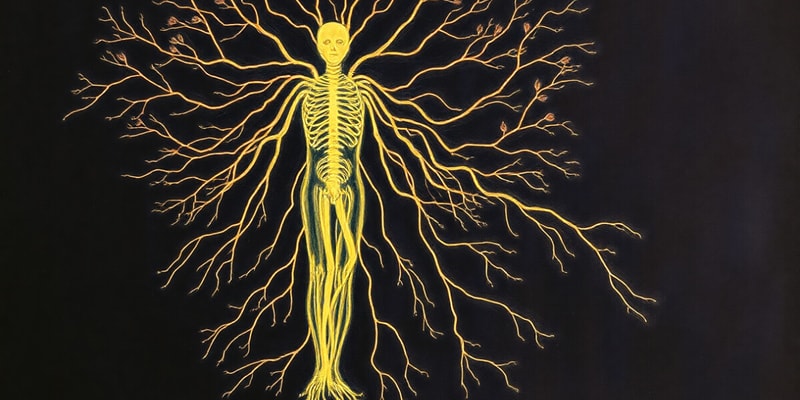Podcast Beta
Questions and Answers
What is the main function of neurons in the nervous system?
Which cells form the myelin sheath in the Central Nervous System (CNS)?
What is the primary purpose of the blood-brain barrier?
What are gliomas?
Signup and view all the answers
What do sensory neurons primarily detect?
Signup and view all the answers
What is the primary function of dendrites in a neuron?
Signup and view all the answers
What role does the myelin sheath play in the nervous system?
Signup and view all the answers
Which structure forms the myelin sheath in the peripheral nervous system?
Signup and view all the answers
How does the presence of nodes of Ranvier affect nerve impulse conduction?
Signup and view all the answers
In what way does multiple sclerosis affect the nervous system?
Signup and view all the answers
What is the primary function of the nervous system?
Signup and view all the answers
Which of the following best describes the sensing role of the nervous system?
Signup and view all the answers
What composes the central nervous system?
Signup and view all the answers
How does the nervous system differ from the endocrine system?
Signup and view all the answers
Which type of cells are primarily responsible for transmitting signals in the nervous system?
Signup and view all the answers
Study Notes
Overview of the Nervous System
- Homeostasis requires coordinated activity among organ systems.
- Nervous system components: brain, spinal cord, and nerves.
- Two systems manage cell coordination: the endocrine (hormones) and nervous (electrical signals).
Functions of the Nervous System
- Sensing: Detects internal and external changes using sense organs and nerve endings.
- Integrating: Processes information, relates it to past experiences, and decides appropriate responses.
- Responding: Issues commands to muscles and glands for changes based on processed information.
Divisions of the Nervous System
- Central Nervous System (CNS): Composed of the brain and spinal cord.
- Peripheral Nervous System (PNS): Extensive network of nerves throughout the body.
Nervous System Cells
- Two main cell types: Neurons (signal carriers) and Neuroglia (supportive cells).
Neurons
- Function as impulse-conducting cells, essential for communication within the nervous system.
Neuroglia (Glial Cells)
- Support neurons and maintain their environment.
-
CNS Neuroglia:
- Oligodendrocytes: Form the myelin sheath in CNS, enhancing signal speed.
-
PNS Neuroglia:
- Schwann Cells: Create myelin sheath around peripheral nerves.
Blood-Brain Barrier (BBB)
- Formed by astrocytes and endothelial cells; a semi-permeable membrane protecting the brain.
- Blocks larger molecules while allowing small ones to pass.
- Challenges treatment of brain disorders due to medication barriers.
Gliomas
- Malignant tumors that can grow rapidly; surgery and radiation are the only current treatments due to the BBB's protective nature.
Classes of Neurons
- Sensory Neurons (Afferent): Detect stimuli (e.g., touch, temperature) and transmit information to the CNS.
Neuron Structure
- Cell Body (Soma): Control center containing the nucleus.
- Dendrites: Receive signals from other neurons, directing information to the cell body.
- Axon: Transmits nerve signals away from the cell body; usually singular.
- Myelin Sheath: Insulates the axon, formed by Schwann cells in the PNS, enhancing conduction speed.
- Nodes of Ranvier: Gaps in myelin where action potentials are generated.
- Synaptic Knob: End of axon that branches into terminals for signal transmission.
Myelination
- Increases conduction speed; nerve fibers control skeletal muscles where rapid response is essential.
- The process begins around the 14th week of fetal development and completes by late adolescence.
Multiple Sclerosis (MS)
- A disease where myelin sheaths in the CNS deteriorate and are replaced by plaques, leading to impaired nerve function.
Studying That Suits You
Use AI to generate personalized quizzes and flashcards to suit your learning preferences.
Description
Explore the intricacies of the Nervous System in Chapter 11. This quiz addresses the roles of the brain, spinal cord, and nerves in maintaining homeostasis, as well as the connection between the nervous system and the endocrine system. Test your knowledge on how these systems work together to regulate bodily functions.




